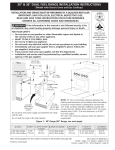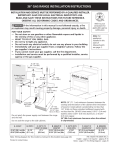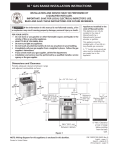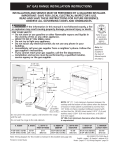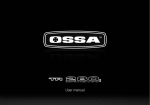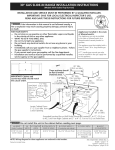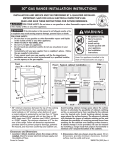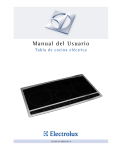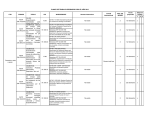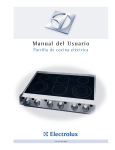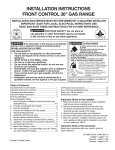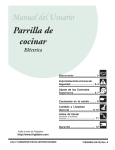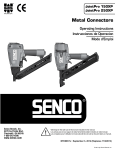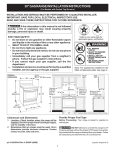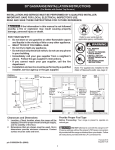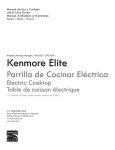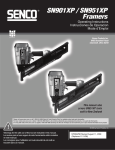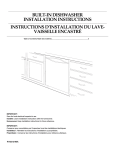Download 30" GAS RANGE INSTALLATION INSTRUCTIONS
Transcript
30" GAS RANGE INSTALLATION INSTRUCTIONS
INSTALLATION AND SERVICE MUST BE PERFORMED BY A QUALIFIED INSTALLER.
IMPORTANT: SAVE FOR LOCAL ELECTRICAL INSPECTOR'S USE.
READ AND SAVE THESE INSTRUCTIONS FOR FUTURE REFERENCE.
OBSERVE ALL GOVERNING CODES AND ORDINANCES.
If the information in this manual is not followed exactly, a fire
or explosion may result causing property damage, personal injury or death.
FOR YOUR SAFETY:
— Do not store or use gasoline or other flammable vapors and liquids in
the vicinity of this or any other appliance.
— WHAT TO DO IF YOU SMELL GAS:
• Do not try to light any appliance.
• Do not touch any electrical switch; do not use any phone in your building.
• Immediately call your gas supplier from a neighbor's phone. Follow the gas
supplier's instructions.
• If you cannot reach your gas supplier, call the fire department.
— Installation and service must be performed by a qualified installer, service
agency or the gas supplier.
29 7/8" Min.
(75.9 cm Min.)
C
Note: For
appliances
installed in
the state of
Massachusetts
see page 2.
B
WALL
WALL
Refer to your
serial plate for
applicable agency
certification
See
note
If there is a wall:
5" Min.
(12.7 cm Min cm Min.)
Left side
18" Min.
(45.7 cm Min.)
G
13" Max.
(33 cm Max.)
A
D
If there is a wall:
5" Min.
(12.7 cm Min.)
Right side
F
E
Recommended
Grounded
Wall Outlet
Location
24" Min.
(61 cm Min.)
24 1/2" Max.
(62.2 cm Max.)
Do not pinch the power supply cord between the range
and the wall.
Do not seal the range to the side cabinets.
NOTE: 24" (61 cm) minimum clearance between the
cooktop and the bottom of the cabinet when the bottom
of wood or metal cabinet is protected by not less than
1/4" (0.64 cm) flame retardant millboard covered with
not less than No. 28 MSG sheet metal, 0.015" (0.4 mm)
stainless steel, 0.024" (0.6 mm) aluminum, or 0.020"
(0.5 mm) copper.
30" (76.2 cm) minimum clearance when the cabinet is
unprotected.
Figure 1
C. DEPTH TO
D. HEIGHT OF
FRONT OF RANGE
COOKTOP
27 1/2"
35 3/4" (90.8 cm) Min.
41 5/8" (105.7 cm) Min. 29 7/8"
(69.9 cm)
36 3/4" (93.3 cm) Max.
42 5/8" (108.3 cm) ( 75.9 cm)
Max.
A. HEIGHT
B. WIDTH
E. DEPTH WITH
DOOR OPEN
45 1/2"
(115.6 cm)
Note: Wiring diagram for this model is enclosed in this booklet (see page 20).
Printed in Canada
1
G. MINIMUM
F. HEIGHT OF
CUTOUT WIDTH
COUNTERTOP
30 1/16"
36" (91.4 cm) Standard
(76.4 cm)
35 3/4" (90.8 cm) Min.
P/N 318201775 (1302) Rev. E
English - pages 1-10; Español - páginas 11-19
Wiring Diagram - page 20
30" GAS RANGE INSTALLATION INSTRUCTIONS
IMPORTANT SAFETY
INSTRUCTIONS
Never leave children alone or
unattended in the area where an appliance is in
use. As children grow, teach them the proper, safe use
of all appliances. Never leave the oven door open when
the range is unattended.
Installation of this range must conform with local codes
or, in the absence of local codes, with the National Fuel
Gas Code ANSI Z223.1 / NFPA 54.
Stepping, leaning or sitting on the
door of this range can result in serious injuries and
can also cause damage to the range.
This range has been design certified by CSA
international. As with any appliance using gas and
generating heat, there are certain safety precautions you
should follow. You will find them in the Use and Care
Guide, read it carefully.
• Do not store items of interest to children in
the cabinets above the range. Children could be
seriously burned climbing on the range to reach items.
• To eliminate the need to reach over the surface
units, cabinet storage space above the units
should be avoided.
• Adjust surface burner flame size so it does not
extend beyond the edge of the cooking utensil.
Excessive flame is hazardous.
• Do not use the oven as a storage space. This
creates a potentially hazardous situation.
• Never use your range for warming or heating the
room. Prolonged use of the range without adequate
ventilation can be dangerous.
• Do not store or use gasoline or other flammable
vapors and liquids near this or any other
appliance. Explosions or fires could result.
• In the event of an electrical power outage, the surface
burners can be lit manually. To light a surface burner,
hold a lit match to the burner head and rapidly turn
the Surface Control knob to Med. Use caution when
lighting surface burners manually.
• Remove broiler pan, food and other utensils
before self-cleaning the oven. Wipe up excess
spillage. Follow the cleaning instructions in the Use &
Care Guide.
• Unlike the standard gas range, THIS COOKTOP
IS NOT REMOVABLE. Do not attempt to remove the
cooktop.
• Be sure your range is installed and grounded
properly by a qualified installer or service
technician.
• This range must be electrically grounded in
accordance with local codes or, in their absence,
with the National Electrical Code ANSI/NFPA No.
70—latest edition in the United States or with
CSA standard C22.1, Canadian Electrical Code,
Part 1 in Canada.
• All ranges can
tip.
• Injury to
persons could
result.
• Install anti-tip
device packed
with range.
To reduce
the risk of tipping of the range,
the range must be secured
by properly installed anti-tip
bracket(s) provided with the
range. To check if the bracket
is installed properly, grasp the
top rear edge of the range and
carefully tilt it forward to make
sure the range is anchored.
• Air curtain or other overhead hoods, which operate
by blowing a downward air flow on to a range, shall
not be used in conjunction with gas ranges other
than when the hood and range have been designed,
tested and listen by an independent test laboratory
for use in combination with each other.
• Make sure the wall coverings around the range
can withstand the heat generated by the range.
• Before installing the range in an area covered
with linoleum or any other synthetic floor
covering, make sure the floor covering can
withstand heat at least 90°F/32°C above room
temperature without shrinking, warping or
discoloring. Do not install the range over carpeting
unless you place an insulating pad or sheet of 1/4"
(6.4 mm) thick plywood between the range and
carpeting.
• Do not obstruct the flow of combustion air at the
oven vent nor around the base or beneath the
lower front panel of the range. Avoid touching the
vent openings or nearby surfaces as they may become
hot while the oven is in operation. This range requires
fresh air for proper burner combustion.
Special Instructions for appliances installed in the State
of Massachusetts: This appliance can only be installed
in the State of Massachusetts by a Massachusetts
licensed plumber or gas fitter. When using a flexible
gas connector, it must not exceed 3 feet (36 inches) in
length. A "T" handle type manual gas valve must be
installed in the gas supply line to this appliance.
Never cover any slots, holes or
passages in the oven bottom or cover an entire rack
with materials such as alminum foil. Doing so blocks
air flow through the oven and may cause carbon
monoxide poisoning. Aluminum foil linings may also
trap heat, causing a fire hazard.
2
30" GAS RANGE INSTALLATION INSTRUCTIONS
Important Notes to the Installer
2. Electrical Requirements
1. Read all instructions contained in these installation
instructions before installing range.
2. Remove all packing material from the oven
compartments before connecting the electrical supply
to the range.
3. Observe all governing codes and ordinances.
4. Be sure to leave these instructions with the consumer.
5. Note: For operation at 2000 ft. elevations above see
level, appliance rating shall be reduced by 4 percent
for each additional 1000 ft.
120 volt, 60 Hertz, properly grounded dedicated circuit
protected by a 15 amp circuit breaker or time delay fuse.
Do not use an extension cord with this range.
Grounding Instructions
IMPORTANT Please read carefully.
For personal safety, this appliance must be properly
grounded.
Important Note to the Consumer
The power cord of this appliance is equipped with a
3-prong (grounding) plug which mates with a standard
3-prong grounding wall receptacle (see Figure 3) to
minimize the possibility of electric shock hazard from the
appliance.
Keep these instructions with your owner's guide for future
reference.
Optional Items Available:
• A Stainless Steel Kick plate
• A Black Knob kit
Those kits can be ordered for purchase through an
Electrolux Service Center at 1-877-4ELECTROLUX (1-877435-3287).
The wall receptacle and circuit should be checked by
a qualified electrician to make sure the receptacle is
properly grounded.
Where a standard 2-prong wall receptacle is installed,
it is the personal responsibility and obligation of the
consumer to have it replaced by a properly grounded
3-prong wall receptacle.
1. Model and Serial Number Location
The serial plate is located on the bottom trim and is
visible when the door is open.
Preferred Method
Grounding type
wall receptacle
When ordering parts for or making inquires about your
oven, always be sure to include the model and serial
numbers and a lot number or letter from the serial plate
on your oven.
Serial Plate Location
A serial plate is located
on the lower trim and
visible when the oven
door is opened.
Figure 3
Do not, under any
circumstances, cut,
remove, or bypass
the grounding
prong.
Power supply cord with
3-prong grounding plug.
Do not, under any circumstances, cut or remove the
third (ground) prong from the power cord.
Disconnect electrical supply cord from
wall receptacle before servicing range.
Figure 2
Gas Connector
3
30" GAS RANGE INSTALLATION INSTRUCTIONS
3. Gas Supply Installation
Suggested gas connection
GAS FLOW
Manual
Flare
Shutoff
Union
Valve
When shipped from the factory, this unit is designed
to operate on 4"(10,16 cm) water column (1.0 kPa)
Natural gas manifold pressure. A convertible pressure
regulator is connected to the range manifold and MUST
be connected in series with the gas supply line. The gas
connector is located as shown on figure 2. It is accessible
from front of the range.
On
Nipple
Pressure
Regulator
Flare
Union
Nipple
Flexible
Connector
Access
Cap
All connections must be wrench-tightened
Figure 4
Assemble the flexible connector from the gas supply pipe
to the pressure regulator in the following order:
1. Manual shut-off valve (not supplied)
2. 1/2" nipple (not supplied)
3. 1/2" flare union adapter (not supplied)
4. Flexible connector (not supplied)
5. 1/2" flare union adapter (not supplied)
6. 1/2" nipple (not supplied)
7. Pressure regulator (supplied)
Off
For proper operation, the maximum inlet pressure to
the regulator should be no more than 14"(35,56 cm) of
water column pressure (3.5 kPa).
The inlet pressure to the regulator must be at least 1"
(.25 kPa) greater than the regulator manifold pressure
setting. The regulator is set for 4"(10,16 cm) water
column (1.0 kPa) Natural gas manifold pressure; the inlet
pressure must be at least 5"(12.60 cm) water column
(1.25 kPa) Natural gas. For LP/Propane gas, the regulator
must be set for 10"(25,4 cm) water column (2.5 kPa)
manifold pressure; the inlet pressure must be at least
11"(27,9 cm) water column (2.75 kPa).
to
The supply line should be equipped with an approved
shutoff valve (see Figure 4 and 5). This valve should be
located in the same room as the range and should be
in a location that allows ease of opening and closing.
Do not block access to the shutoff valve. The valve is for
turning on or shutting off gas to the appliance. Open the
shutoff valve in the gas supply line. Wait a few minutes
for gas to move through the gas line.
ap
pli
an
ce
to
The gas supply between the shutoff valve and the
regulator may be connected by rigid piping or by CSAapproved flexible metallic union-connected piping where
local codes permit use.
Shutoff Valve Open position
ga
ss
up
ply
lin
e
Figure 5
The gas supply piping can be through the side wall of
the right cabinet. The left side cabinet is an ideal location
for the main shutoff valve, if the range is installed within
cabinet storage space
Do not make the connection too tight.
The regulator is die cast. Overtightening may crack the
regulator resulting in a gas leak and possible fire or
explosion.
Use pipe-joint compound made for use with Natural and
LP/Propane gas to seal all gas connections. If flexible
connectors are used, be certain connectors are not
kinked.
The supply line must be equipped with an approved
manual shutoff valve. This valve should be located in
the same room as the range and should be in a location
that allows ease of opening and closing. Do not block
access to the shutoff valve. The valve is for turning on or
shutting off gas to the appliance.
The gas supply line to the shutoff valve should be
1/2"(1,27 cm) or 3/4"(1.9 cm) solid pipe.
Once regulator is in place, open the shutoff valve in the
gas supply line. Wait a few minutes for gas to move
through the gas line.
Connection to Pressure Regulator
The regulator is already installed on the appliance.
The user must know the location of the main shutoff
valve and have easy access to it.
Check for leaks. After connecting the range to the gas
supply, check the system for leaks with a manometer.
If a manometer is not available, turn on the gas supply
and use a liquid leak detector (or soap and water) at all
joints and connections to check for leaks. Leaks will be
indicated by bubbles appearing at the connections or
joints.
When using flexible gas conduit on the range, allow
sufficient slack to pull the range outside the cutout for
cleaning or servicing.
NOTE: Do not allow the flexible conduit to get pinched
between the wall and the range.
4
30" GAS RANGE INSTALLATION INSTRUCTIONS
6. Range Placement
Do not use a flame to check for leaks
from gas connections. Checking for leaks with a flame
may result in a fire or explosion.
To eliminate the risk of burns or fire from
reaching over heated surface units, cabinet storage space
located above the range should be avoided. If cabinet
storage space is to be provided, the risk can be reduced
by installing a range hood that projects horizontally a
minimum of 5" (12.7 cm) beyond the bottom of the
cabinet.
All openings in the wall or floor where the range is to be
installed must be sealed.
Tighten all connections if necessary to prevent gas
leakage in the cooktop or supply line.
Disconnect this range and its individual shutoff
valve from the gas supply piping system during any
pressure testing of the system at test pressures greater
than 1/2 psig (3.5 kPa or 14"(35,56 cm) water column).
Isolate the range from the gas supply piping system
by closing its individual manual shutoff valve during
any pressure testing of the gas supply piping system at
test pressures equal to or less than 1/2 psig (3.5 kPa or
14"(35,56 cm) water column).
Center
Line of
Range
Follow instructions for
the type of installation you have
4. LP/Propane Gas Conversion
Figure 6
This appliance can be used with Natural gas or LP/
Propane gas. It is shipped from the factory for use with
natural gas.
If range will be installed with a cabinet on both
sides, draw a center line on the floor between the
cabinets (see figure 6). If back of range will not be
flush with the wall (the location of the outlet may not
allow the range to be positioned against the wall), draw
a line on the floor where the back edge of the range will
be. Now install anti-tip bracket (see "Anti-Tip Bracket
Installation", page 9).
If you wish to convert your range for use with LP/
Propane gas, use the supplied fixed orifices located in a
bag containing the literature marked "FOR LP/PROPANE
GAS CONVERSION." Follow the instructions packaged
with the orifices.
The conversion must be performed by a qualified service
technician in accordance with the manufacturer's
instructions and all local codes and requirements. Failure
to follow these instructions could result in serious injury
or property damage. The qualified agency performing
this work assumes responsibility for the conversion.
If range will be installed with a cabinet on one
side only, move the range into final position. Draw a
line on the floor along the side of the range that is not
against the cabinet. If back of range will not be flush
with the wall (the location of the outlet may not allow
the range to be positioned against the wall), draw a
line on the floor where the back edge of the range will
be. Now install anti-tip bracket (see "Anti-Tip Bracket
Installation", page 9).
Failure to make the appropriate
conversion can result in personal injury and property
damage.
5. Moving the Appliance for
Servicing and Cleaning
If range will not be installed against a cabinet, move
range into final position. Draw a line on the floor along
both sides of the range. If back of range will not be
flush with the wall (the location of the outlet may not
allow the range to be positioned against the wall), draw
a line on the floor where the back edge of the range will
be. Now install anti-tip bracket (see "Anti-Tip Bracket
Installation", page 9).
Turn off the range line fuse or circuit breakers at the
main power source, and turn off the manual gas shut-off
valve. Make sure the range is cold. Open the oven door.
Lift the range at the front and slide it out of the cut-out
opening without creating undue strain on the flexible
gas conduit. Make sure not to pinch the flexible gas
conduit at the back of the range when replacing the unit
into the cut-out opening. Close the door and switch on
the electrical power and gas to the range.
5
30" GAS RANGE INSTALLATION INSTRUCTIONS
7.2 Check Operation
7. Range Installation
Refer to the Use and Care Guide and the Electronic Oven
Control Guide packaged with the range for operating
instructions and for care and cleaning of your range.
1. The back of the range may be installed directly
against the wall.
2. To reduce possible scorching of vertical walls and
to minimize potential fire hazards under abnormal
surface unit use conditions such as high heat or no
pans and to conform to Agency requirements:
- A minimum of 5" (17.8 cm) spacing should be
provided on both sides of the cooktop.
Remove all packaging from the oven before testing.
1. Burner Bases and Burner Caps
This range is equipped with sealed burners as shown
(Figure 8). All pieces are at their place. Take note where
they are. Remove all packaging material located
under the Dual Surface burner head. Make sure the
burner is properly aligned and leveled. NOTE: There are
no burner adjustments necessary on this range.
Excessive Weight Hazard
• Use 2 or more people to move and install range.
• Failure to follow this instruction can result in
back or other injury.
Burner Cap
Burner Cap
Burner Base
7.1 Leveling the Range
1. Install an oven rack in the center of the oven.
2. Place a level on the rack (see Figure 7). Take 2
readings with the level placed diagonally in one
direction and then the other. Level the range, if
necessary, by adjusting the 4 leveling legs with a
wrench (see page 9).
3. Slide the range to its final position and double check
for levelness. If the range is not level, pull unit out
and readjust leveling legs, or make sure floor is level.
Fixed Burner Ring
and Burner Base
Regular Burner
Fixed Burner Ring
Figure 8
Dual Surface
Burner
2. Turn on Electrical Power and Open Main Shutoff
Gas Valve
3. Check the Igniters
Operation of electric igniters should be checked after
range and supply line connectors have been carefully
checked for leaks and range has been connected to
electric power. To check for proper lighting:
a. Push in and turn a surface burner knob to the LITE
position. All electronic surface ignitors will spark at the
same time. However, only the burner you are turning
on will ignite.
b. The surface burner should light once the flow of gas
reached the surface burner. Each burner should light
within four (4) seconds in normal operation after air
has been purged from supply lines. Visually check that
burner has lit.
c. Once the burner lights, the control knob should be
rotated out of the LITE position.
There are separate ignition devices for each burner. Try
each knob separately until all burner valves have been
checked.
Figure 7
6
30" GAS RANGE INSTALLATION INSTRUCTIONS
5. Adjust the "LOW" Setting of the Dual Burner
(see Figure 8) on the Surface Burner Valve (Figure
10):
Note: On the dual valve the low setting of each portion
(rear portion of bridge burner and the center portion of
bridge burner) should be adjusted individually.
a. Push in and turn control to LITE until the rear portion
of the bridge burner ignites only.
b. Quickly turn knob to LOWEST POSITION.
c. If burner goes out, reset control to OFF.
d. Remove the surface burner control knob.
e. The inner portion of the dual burner flame size can be
increased or decreased by turning screw A (see Figure
10). Use screw B to adjust the flame size of the outer
portion of the dual burner. Turn counterclockwise
the screw to increase flame size. Turn clockwise the
screw to decrease flame size. Adjust flame until you
can quickly turn knob from LITE to LOWEST POSITION
without extinguishing the flame. Flame should be as
small as possible without going out.
Note: Air mixture adjustment is not required on surface
burners.
4. Adjust the "LOW" Setting of Regular Burner (see
figure 8) on the Surface Burner Valves (Figure 9):
a. Push in and turn control to LITE until burner ignites.
b. Quickly turn knob to LOWEST POSITION.
c. If burner goes out, reset control to OFF.
d. Remove the surface burner control knob and
decorative ring.
e. Insert a thin-bladed screwdriver into the hollow valve
stem and engage the slotted screw inside. Flame
size can be increased or decreased by turning the
screw. Turn counterclockwise to increase flame size.
Turn clockwise to decrease flame size. Adjust flame
until you can quickly turn knob from LITE to LOWEST
POSITION without extinguishing the flame. Flame
should be as small as possible without going out.
Note: Air mixture adjustment is not required on surface
burners.
Figure 9
B
A
Figure 10
7
30" GAS RANGE INSTALLATION INSTRUCTIONS
8.2 Oven Burner Flame Adjustment
The approximate oven burner flame length is 1 inch
(distinct inner cone of blue flame).
8. Operation of Oven Burners and Oven
Adjustments
8.1 Electric Ignition Burners
Operation of electric igniters should be checked after
range and supply line connectors have been carefully
checked for leaks, and range has been connected to
electric power.
To determine if the oven burner flame is proper, remove
the oven bottom and burner baffle and set the oven to
bake at 300°F.
To remove the oven bottom, remove oven hold down
screws at rear of oven bottom. Pull up at rear, disengage
front of oven bottom from oven front frame, and pull the
oven bottom out of the oven. Remove burner baffle so
that burner flame can be observed.
The oven burner is equipped with an electric control
system as well as an electric oven burner igniter. If your
model is equipped with a waist-high broil burner igniter,
it will also have an electric burner igniter. These control
systems require no adjustment. When the oven is set to
operate, current will flow to the igniter. It will "glow"
similar to a light bulb. When the igniter has reached
a temperature sufficient to ignite gas, the electrically
controlled oven valve will open and flame will appear
at the oven burner. There is a time lapse from 30 to 60
seconds after thermostat is turned ON before the flame
appears at the oven burner. When the oven reaches the
display setting, the glowing igniter will go off. The burner
flame will go "out" in 20 to 30 seconds after igniter goes
"OFF". To maintain any given oven temperature, this cycle
will continue as long as the display is set to operate.
If the flame is yellow, increase air shutter opening size (see
"2" in Figure 12). If the entire flame is blue, reduce the air
shutter opening size.
To adjust flame loosen lock screw (see "3" in Figure 12),
reposition air shutter, and tighten lock screw. Replace oven
bottom.
Oven Burner Tube
3 Lock Screw
After removing all packing materials and literature
from the oven:
a) Set the oven to BAKE at 300°F. See Use & Care Guide
for perating instructions.
b) Within 60 seconds the oven burner should ignite. Check
for proper flame (see 6.2), and allow the urner to cycle
once (see cycle explanation above). Reset controls to off.
c) If your model is equipped with a waist-high broiler
burner, set oven to broil. See Use & Care Guide for
operating instructions.
d) Within 60 seconds the broil burner should ig ite. Check
for proper flame (see 6.3). Reset controls o off.
2 Air Shutter
o
Figure 12
1 Orifice Hood
b
6.3 Broil Burner Flame Adjustment
The approximate flame length of the burner is 1 inch
(distinct inner cone of blue flame). To determine if the broil
burner flame is proper, set the oven to broil. If flame is
yellow, increase air shutter opening size (see "2" in Figure
12 ). If the entire flame is blue, reduce the air shutter
opening size. To adjust, loosen lock screw (see "3" in
Figure 12), reposition air shutter, and tighten lock screw.
n
t
Lower
Oven Burner
Baffle
(removable)
Figure 11
When All Hookups are Complete
Waist-High Burner
Air Shutter
Make sure all controls are left in the OFF position.
Before You Call for Service
Read the Before You Call for Service Checklist and
operating instructions in your Use and Care Guide.
It may save you time and expense. The list includes
common occurrences that are not the result of defective
workmanship or materials in this appliance.
Lower Oven Bottom
Air Shutter (removable)
Refer to your Use and Care Guide for Electrolux Service
phone numbers, or call 1-877-4ELECTROLUX (1-877435-3287).
8
30" GAS RANGE INSTALLATION INSTRUCTIONS
Important Safety Warning
4. Mark on the floor the location of the mounting holes
shown on the template (right and left position). For
easier installation, 3/16" (4.8 mm) diameter pilot holes
1/2" (1.3 cm) deep can be drilled into the floor.
5. Remove template and place bracket on floor (see
figure 13). Line up holes in bracket with marks
on floor and attach the bracket using the screws
provided. Brackets must be secured to solid floor. If
attaching to concrete floor, first drill 3/16" (4.8 mm)
dia. pilot holes using a masonry drill bit.
6. Level range if necessary, by adjusting the 4 leveling
legs with an adjustable wrench. Loosen the screw
which fixes the decorative leg and lift it to reach the
leveling leg. Turn the leveling leg counterclockwise
to raise the range or clockwise to lower the range
(see Figure 14). Replace the decorative legs at your
convenience.
7. Before sliding the range to its final position; take note
of the serial and model numbers for future reference.
Slide range into place making sure rear leg is trapped
by the bracket. Range may need to be shifted slightly
to one side as it is being pushed back to allow rear leg
to align with bracket.
8. After installation, visually verify that the anti-tip
brackets are engaged.
To reduce the risk of tipping of the range, the range
must be secured to the floor by the properly installed
anti-tip bracket and screws packed with the range. These
parts are located in a plastic bag in the oven. 30" Range
has one bracket. Failure to install the bracket will allow
the range to tip over if excessive weight is placed on
an open door or if a child climbs upon it. Serious injury
might result from spilled hot liquids or from the range
itself.
Follow the instructions below to install the anti-tip bracket.
If range is ever moved to a different location, the anti-tip
bracket must also be moved and installed with the range.
Tools Required:
5/16" (8 mm) Nut driver or Flat Head Screwdriver
Adjustable Wrench
Electric Drill
3/16" (4.8 mm) Diameter Drill Bit
3/16" (4.8 mm) Diameter Masonry Drill Bit (if installing in
concrete)
Anti-Tip Bracket Installation
1. The anti-tip bracket must be install on the right or the
left side at back of the range.
2. The anti-tip bracket supports are attached to the floor
at the back. When fastening to the floor, be sure that
screws do not penetrate electrical wiring or plumbing.
The screws provided will work in either wood or
concrete.
3. Unfold paper template and place it flat on the floor
with the back and side edges positioned exactly where
the back and sides of range will be located when
installed. (Use the diagram in figure 13 to locate
bracket if template is not available.)
Range
Base of
ll
Wa
B
A
Leveling
Leg
Decorative
Leg Screw
Raise
Lower
A B
ll
Wa
Cen
ter
Line
Figure 14
Figure 13
30" range: Install the anti-tip bracket on the right or left side.
9
30" Range
A
B
11 5/16 (28.7 cm)
2 1/2 (6.4 cm)
30" GAS RANGE INSTALLATION INSTRUCTIONS
NOTES:
10
INSTRUCCIONES DE INSTALACIÓN PARA LA ESTUFA DE GAS
LA INSTALACIÓN Y EL SERVICIO DEBEN SER EFECTUADOS POR UN INSTALADOR CALIFICADO.
IMPORTANTE: GUARDE ESTAS INSTRUCCIONES PARA USO DEL INSPECTOR LOCAL DE
ELECTRICIDAD. LEA Y GUARDE ESTAS INSTRUCCIONES PARA REFERENCIA FUTURA.
OBSERVE CÓDIGOS GOBERNANTES Y ORDENANZAS.
Si la información contenida en este manual no es seguida exactamente,
puede ocurrir un incendio o explosión causando daños materiales, lesión personal o la
muerte.
PARA SU SEGURIDAD:
— No almacene ni utilice gasolina u otros vapores y líquidos inflamables en la
proximidad de éste o de cualquier otro electrodoméstico.
— QUE DEBE HACER SI PERCIBE UN OLOR A GAS:
• No trate de encender ningún electrodoméstico.
• No toque ningún interruptor eléctrico; no use ningún teléfono en su edificio.
• Llame a su proveedor de gas desde el teléfono de un vecino. Siga las instrucciones
del proveedor de gas.
• Si no logra comunicarse con su proveedor de gas, llame al departamento de
bomberos.
— La instalación y el servicio de mantenimiento deben ser efectuados por un instalador
calificado, la agencia de servicio o el proveedor de gas.
29 7/8" Mín.
(75.9 cm Mín.)
C
B
PARED
PARED
Nota: Para
electrodomésticos
instalados en
el estado de
Massachussets.
Vea página 12.
Véa
Nota
Si hay una pared:
5" Mín.
(12.7 cm Mín.)
lado izquierdo
18" Mín.
(45.7 cm Mín.)
13" Max.
(33 cm Max.)
A
D
G
Si hay una pared:
5" Mín.
(12.7 cm Mín.)
lado derecho
F
E
24" Mín.
(61 cm Mín.)
24 1/2" Máx.
(62.2 cm Máx.)
Tomacorriente de pared
puesto a tierra
No pellizque el cordón eléctrico entre la estufa y la pared.
No selle la estufa a los armarios laterales.
NOTA: Un espacio mínimo de 24" (61 cm) entre la
superficie de la estufa y el fondo del armario cuando el
fondo del armario de madera o metal está protegido
por no menos de 1/4" (0.64 cm) de madera resistente al
fuego cubierta por una lámina metálica de MSG, número
28, 0.015" (0.4 mm) de acero inoxidable, 0.024" (0.6
mm) de aluminio, o 0.02" (0.5 mm) de cobre.
Un espacio mínimo de 30" (76.2 cm) cuando el armario
no está protegido.
Figura 1
A. ALTURA
B. ANCHO
41 5/8" (105.7 cm) Min.
29 7/8"
42 5/8" (108.3 cm) Max. ( 75.9 cm)
C. PROFUNDIDAD AL
FRENTE DE LA ESTUFA
D. Altura de la
cubierta
E. PROFUNDIDAD CON
PUERTA ABIERTA
F. ALTURA DE
MOSTRADOR
G. Ancho mínimo
para la abertura
27 1/2"
(69.9 cm)
35 3/4" (90.8 cm) Min.
36 3/4" (93.3 cm) Max.
45 1/2"
(115.6 cm)
36" (91.4 cm) Standard
35 3/4" (90.8 cm) Min.
30 1/16"
(76.4 cm)
El diagrama del cableado de este modelo está incluido en esta manual (vea la pagina 20).
Impreso en Canada
11
P/N 318201775 (1302) Rev. E
English - pages 1-10; Español - páginas 11-19
Diagrama de la instalación alámbrica - página 20
INSTRUCCIONES DE INSTALACIÓN PARA LA ESTUFA DE GAS
IMPORTANTES INSTRUCCIONES
DE SEGURIDAD
• No obstruya el flujo del aire de combustión en la
ventilación del horno ni tampoco alrededor de
la base o debajo del panel inferior delantero de
la estufa. Evite tocar las aberturas o áreas cercanas
de la ventilación, ya que pueden estar muy calientes
durante el funcionamiento del horno. La estufa
requiere aire fresco para la combustión apropiada de
los quemadores.
Instalación de esta estufa debe cumplir con todos los códigos
locales, o en ausencia de códigos locales con el Código
Nacional de Gas Combustible ANSI Z223.1/NFPA 54.
Esta estufa ha sido diseñada y certificada por el organismo
CSA Internacional. Como en cualquier electrodoméstico
donde se use gas y se genere cierto calor, existen diversas
precauciones de seguridad que deben ser seguidas. Usted
encontrará esta lista de precauciones en el manual de Uso y
Cuidado, por favor léalas cuidadosamente.
• Asegúrese de que la estufa sea instalada y
conectada a tierra en forma apropiada por un
instalador calificado o por un técnico.
• Esta estufa debe ser eléctricamente puesta a
tierra de acuerdo con los códigos locales, o en su
ausencia, con el Código Eléctrico Nacional ANSI/
NFPA No. 70, última edición.
Nunca deje niños solos
o desatendidos en un área donde un
electrodoméstico está siendo usado. A medida que
los niños crecen, enséñeles el uso apropiado y seguro
para todos los electrodomésticos. Nunca deje la puerta
del horno abierta cuando la estufa está desatendida.
No se pare, apoye o siente en
las puertas o cajones de esta estufa pues puede
resultar en serias lesiones y puede también causar
daño a la estufa.
• No almacene artículos que puedan interesar a los
niños en los gabinetes sobre la estufa. Los niños
pueden quemarse seriamente tratando de trepar a la
estufa para alcanzar estos artículos.
• Los gabinetes de almacenamiento sobre la estufa
deben evitarse, para eliminar la necesidad de
tener que pasar sobre los elementos superiores de
la estufa para llegar a ellos.
• Ajuste el tamaño de la llama de los quemadores
superiores de tal manera que ésta no sobrepase el
borde de los utensilios de cocinar. La llama excesiva
es peligrosa.
• No use el horno como espacio de almacenaje. Esto
creará una situación potencialmente peligrosa.
• Nunca use la estufa para calentar el cuarto. El uso
prolongado de la estufa sin la adecuada ventilación
puede resultar peligroso.
• No almacene ni utilice gasolina u otros vapores y
líquidos inflamables en la proximidad de éste o de
cualquier otro electrodoméstico eléctrico. Puede
provocar incendio o explosión.
• En caso de una interrupción del servicio eléctrico, es
posible de encender los quemadores de superficie a
mano. Para encender un quemador de superficie, acerque
un fósforo encendido a la cabezal del quemador, y gire
rápidamente el botón de control de superficie a Med.
Tenga cuidado al encender los quemadores a mano.
• Retire el sartén asador, alimentos o cualquier
otro utensilio antes de ajustar un ciclo de autolimpieza en el horno. Limpie el exceso de derrames.
Siga las instrucciones en manual de Uso y Cuidado.
• A diferencia de otras cubiertas a gas, ESTA
CUBIERTA no es removible. No intente remover esta
cubierta.
• Todas las estufas pueden volcarse.
• Esto podría resultar en lesiones personales.
• Instale el dispositivo antivuelco provisto con
esta estufa.
Para reducir el riesgo de que se vuelque la
estufa, hay que asegurarla adecuadamente
colocando Los soportes antivuelco que se
proporcionan. Para comprobar si estos estan
instalados y apretados correctamente, tome el borde
trasero superior de la estufa y cuidadosamente inclínela
hacia adelante para asegurarse que la estufa esté anclada.
• No se deben usar cortinas de aire ni ninguna
otra campana de ventilación superior que sople
aire hacia abajo sobre la estufa a gas a menos
que la campana de ventilación y la estufa hayan
sido diseñadas, probadas y certificadas por un
laboratorio de pruebas independiente para el uso
combinado de la una con la otra.
• Asegúrese de que el material que recubre las
paredes alrededor de la estufa, pueda resistir el
calor generado por la estufa.
• Antes de instalar la estufa en un área cuyo
piso este recubierto con linóleo u otro tipo de
piso sintético, asegúrese de que éstos puedan
resistir una temperatura de por lo menos 90°F
sobre la temperatura ambiental sin provocar
encogimiento, deformación o decoloración. No
instale la estufa sobre una alfombra al menos que
coloque una plancha de material aislante de por lo
menos 1/4 pulgada, entre la estufa y la alfombra.
Instrucciones especiales para los electrodomésticos instalados
en el estado de Massachussets: Este electrodoméstico puede
ser solamente instalado en el estado de Massachussets por un
plomero calificado o instalador de gas con licencia en el estado
de Massachussets. Cuando se utilice un conector flexible de
gas, éste no debe de exceder 3 pies (36 pulgadas) de largo.
Una válvula manual de tipo “T” debe de instalarse en la línea
de alimentación de gas hacia este electrodoméstico.
No utilice película de aluminio a la
base del horno u otra parte del aparato. Sólo utilizela
para cubrir la comida cuando esté cociéndola. Cualquier
otra utilización puede ocasionar un incendio, una
electrocución o un cortocircuito.
12
INSTRUCCIONES DE INSTALACIÓN PARA LA ESTUFA DE GAS
Notas importantes para el Instalador
2. Requisitos eléctricos
1. Lea todas las instrucciones contenidas en este manual
antes de instalar la estufa.
2. Saque todo el material usado en el empaque del
compartimiento del horno antes de conectar el
suministro eléctrico a la estufa.
3. Observe todos los códigos y reglamentos pertinentes.
4. Deje estas instrucciones con el comprador.
5. Nota: Para el correcto funcionamiento en lugares
superiores a los 2000 ft, el régimen del mecanismo debe
reducirse un 4% por cada 1000 ft sobre el nivel del mar.
120 voltio, 60 Hertzio, circuito dedicado apropiadamente
puestos a tierra protegido por un circuito de amperio o
fusible de demora de tiempo de 15 amp.
No utilice una extensión con esta estufa.
Instrucciones de puesta a tierra
IMPORTANTE Por favor lea con cuidado.
Para la seguridad personal, este aparato debe ser
puesto a tierra apropiadamente.
El cable del suministro eléctrico de esta estufa está
equipado con un enchufe de tres patillas (para puesta a
tierra) que coincida con un enchufe de pared estándar
con puesta a tierra de tres patillas para minimizar la
posibilidad que se produzcan descargas eléctricas.
El cliente deberá encargar a un técnico para asegurarse
de que el enchufe se encuentra debidamente conectado
a tierra y polarizado.
En lugares en los que aya un enchufe de pared estándar
de dos patillas, el cliente tendrá responsabilidad directa
y la obligación de reemplazarlo por un enchufe de pared
de tres patillas debidamente cableado a tierra.
Nota Importante para el Consumidor
Conserve estas instrucciones y el Manual del Usuario para
referencia futura.
Artículos Disponibles Opcionales:
• Una Kick plata de Acero Inoxidable.
• Un empaque de perillas negro.
Estos juegos se pueden ordenar para comprar mediante
Service Center 1-877-4ELECTROLUX (1-877-435-3287).
1. Ubicación del Número de Modelo y de
Serie
Método preferido
Enchufe de pared
con toma de
tierra
La placa de serie se encuentra en la parte trasera de la estufa.
Cuando haga pedidos de repuestos o solicite información
con respecto a su estufa, esté siempre seguro de incluir
el número de modelo y de serie y el número o letra del
lote de la placa de serie de su estufa.
No corte, retire o
deribe, bajo ninguna
circunstancia, la
patilla de la toma de
tierra del enchufe
Cable de suministro
eléctrico con enchufe con
toma de tierra
Figura 3
Ubicación de la placa
de serie- Una place de
serie se encuentra sobre
el ribete decorativo y es
visible cuando la puerta
es abierta.
Bajo ninguna circunstancia, corte, retire o derribe
la tercera patilla (de toma de tierra) del cable del
suministro de energía eléctrica.
Desenchufa el cable del suministro
de energía eléctrica del enchufe de pared antes de
mantener la estufa.
Figura 2
Conector de gas
13
INSTRUCCIONES DE INSTALACIÓN PARA LA ESTUFA DE GAS
3. Instalación de la alimentación de
gas
Las conexiones sugeridas en 30" modelo
FLUJO DEL GAS
Regulador
Valvula de
cierre
Unión de presión
Unión
manual
Esta unidad ha sido ajustada de fábrica para operar con
una tubería para gas natural de 4" (1.0 kPa). Un regulador
de presión de conversión está conectado a la válvula
distribuidora y DEBE ser conectado en serie con la tubería
de suministro de gas (figura 2).
Abierto
(On)
Boquilla
Apagado
(Off)
Para la operación apropiada, la máxima presión de
entrada al regulador no debe exceder la presión de una
tubería de agua de 14 pulgadas (3.5 kPa).
Boquilla
Conector
flexible
Tapa de
entrada
Todas las conexiones deben de ser apretadas con una llave.
Figura 4
Monte el conector flexible desde el tubo de suministro
de gas hasta el regulador de presión según este orden:
1. Válvula de cierre manual (no incluido)
2. Boquilla de 1/2" (no incluido)
3. 1/2" Adaptador de unión (no incluido)
4. Conector flexible (no incluido)
5. 1/2" Adaptador de unión (no incluido)
6. Boquilla de 1/2" (no incluido)
7. Regulador de presión (incluido)
La presión de entrada al regulador debe ser por lo menos 1
pulgada más grande que la válvula distribuidora (.25 kPa).
El regulador ha sido ajustado para gas natural a 4 pulgadas
de presión para la válvula distribuidora (1.0 kPa). La presión
de entrada debe ser por lo menos de 5 pulgadas (1.25
kPa). Para propano líquido a 10 pulgadas de presión para la
válvula distribuidora (2.5 kPa) la presión de entrada debe ser
por lo menos de 11 pulgadas (2.75 kPa).
La tubería deberá ser equipada con una válvula de cierre
aprobada (vea Figura 4 & 5). Esta válvula debe ubicarse en
la misma habitación que la estufa en un lugar que permita
una una facilidad de abrir y cerrar. No bloquée el acceso
a la válvula de cierre. La válvula abre o cierra es para abrir
o cerrar el suministro de gas al aparato. Abra la válvula de
cierre en la línea de suministro de gas. Espere unos minutos
a que el gas pase por el tubo.
Ele
ctr
od
om
El suministro de gas entre la válvula de cierre y el regulador
se puede conectar con tubería rígida o con tubería flexible
unión metálica conectada y aprobada por la CSA donde los
códigos locales permiten.
ést
ico
Al
al
Válvula de cierre Abierta
La tubería del suministro de gas puede pasar por la pared
lateral del armario derecho. El armario lateral izquierda es
un lugar ideal para la válvula de cierre pincipal.
ine
ad
eg
as
Figura 5
Use un compuesto para juntas de tubería apropiado para
el uso con gas natural y de LP/Propano para sellar todas
las conexiones de gas. Si se usan conectores flexibles
asegúrese de que no estén enroscados.
La línea del suministro se debe equipar de una válvula
de cierre manual aprobada. Esta válvula se debe localizar
en el mismo cuarto que la estufa y debe estar en una
localización que permita el fácil acceso para abrir y
cerrar. No obstruya el acceso a la válvula. La válvula abre
o cierra el suministro de gas a la estufa.
Conexión del regulador
El regulador esta instalado en el electrodoméstico.
Asegurese de no apretar demasiado la
conexión. El sobre apretar la conexión puede romper el
regulador u generar una fuga de gas y posiblemente un
incendio o explosión.
La tubería de suministro de gas debe ser de 1/2"(1,27
cm) o 3/4"(1.9 cm) D.I.
El consumidor debe saber la posición de la válvula
principal de cierre y tener acceso fácil a esta.
Una vez que regulador está en su lugar, abra la válvula
en la línea del suministro de gas. Espere algunos minutos
para que el gas pase a través de la línea de gas.
NOTA: No permita que el conducto se pellizque entre la
pared y la estufa. Para verlo, saque el cajón.
Asegúrese de que no haya escapes de gas. Después
de conectar la estufa al suministro de gas, compruebe el
sistema con un manómetro. Si no tiene un manómetro,
abra el gas y use un detector de fugas líquido en todas las
juntas y conexiones para averiguar si hay escapes de gas.
14
INSTRUCCIONES DE INSTALACIÓN PARA LA ESTUFA DE GAS
No use flama para verificar que no
hayan pérdidas de gas. La comprobación de pérdidas
de gas con una flama puede resultar en un incendio o
explosión.
6. Estufa - Colocación
Para eliminar el riesgo de quemaduras
o fuego por el contacto de superficies sobrecalentadas,
cualquier espacio de almacenaje en los gabinetes situados
sobre la estufa debe ser evitado. Si un espacio de
almacenaje debe de ser proporcionado, el riesgo puede ser
reducido instalando una campana de estufa que proyecte
horizontalmente e un mínimo de el 5"(12.7 centímetros).
Se debe sellar todas las aberturas en la pared o el piso
donde la estufa esté instalada.
Apriete todas las conexiones si hace falta para
prevenir fugas de gas en la superficie de la estufa o en la
linea de suministro.
Desconecte esta estufa y su válvula individual de
cierre del sistema del siministro de gas durante cualquier
prueba de presión de ese sistema a presiones mayores de
1/2 psig (3.5 kPa o 14"(35,56 cm) columna de agua).
CL
de la
Center
Line of
estufa
Range
Aisle la estufa del sistema del suministro de gas
cerrando su válvula manual de cierre individual durante
cualquier prueba de presión del suministro del gas
a presiones iguales a menos de 1/2 psig (3.5 kPa o
14"(35,56 cm) columna de agua).
Follow
instructions
Siga las
instruccionesfor
theel type
ofinstalación
installation
have
para
tipo de
queyou
usted
tenga
Figura 6
4. Conversión para uso de Propano
Líquido
Si la estufa se va a instalar con armarios laterales,
marque el centro de la abertura del armario en el piso (ver
la figura 6). Si la parte trasera de la estufa no estará
a ras con la pared (la ubicación del tomacorriente puede
que no permita que la estufa se pegue a ras con la pared),
marque el piso donde estará el border trasero de la estufa.
Ponga el patrón en el piso, alineando la línea del centro
del patrón con la marca en el centro de la abertura del
armario. Ponga el borde trasero del patrón a ras contra la
pared trasera o la línea marcada para la parte de atrás de la
estufa.
Este aparato puede ser usado con gas natural o propano
líquido. Ha sido ajustado en la fábrica para operar con
gas natural solamente.
Si desea convertir su estufa para uso con propano
líquido, use las espreas provistas ubicados en el bolso
que contiene la literatura titulada "FOR LP/PROPANE GAS
CONVERSION". Siga las instrucciones que vienen con las
espreas.
La conversión debe efectuarse por un técnico de
servicio capacitado, de acuerdo con las instrucciones
del fabricante y con todos los códigos y requisitos
de las autoridades correspondientes. El no seguir las
instrucciones podría dar como resultado lesiones graves
o daños a la propiedad. El organismo autorizado para
llevar a cabo este trabajo asume la responsabilidad de la
conversión.
Si la estufa se va a instalar con un armario en un sólo
un lado, mueva la estufa a su posición final. Marque el piso
por el lado de la estufa que no estará contra el armario. Si
la parte trasera de la estufa no esta al ras con la pared
(la ubicación del tomacorriente puede que no permita que la
estufa se pegue al ras con la pared), marque el piso donde el
borde trasero de la estufa estará. Ponga el patrón en el piso y
alinie el lado del patrón con la línea marcada en el piso. Alinie
la parte trasera del patrón con la pared trasera o la línea marcada para la parte de atrás de la estufa.
La falta de una conversión apropiada
puede resultar en lesiones graves y daños a la propiedad.
Si la estufa no será instalada junto a un armario, mueva
la estufa a su posición final. Marque el piso por los dos lados
de la estufa. Si la parte trasera de la estufa no estará a
ras con la pared (la ubicación del tomacorriente puede que
no permita que la estufa se pegue a ras con la pared), marque
en el piso donde el borde trasero de la estufa estará. Ponga
el patrón en el piso y alinie los lados del patrón con las líneas
marcadas en el piso. Alinie la parte trasera del patrón con la
pared trasera o la línea marcada para la parte trasera de la
estufa.
5. La mudanza del aparato para
reparaciones o limpieza
Corte la corriente eléctrica a la estufa a la fuente de poder
principal, y cierre la válvula manual de gas. Asegúrese de que
la estufa esté fría. Abra la puerta del horno. Levante el frente
de la estufa y deslícela fuera de la abertura sin crear tensión
desmedida sobre el conducto flexible de gas. Asegúrese de
no pellizcar el conducto flexible de gas detrás de la estufa al
reinstalar la unidad en la abertura. Cierre la puerta y abra el
gas y la corriente eléctrica a la estufa.
15
INSTRUCCIONES DE INSTALACIÓN PARA LA ESTUFA DE GAS
7.2 Comprobación del Funcionamiento
7. Instalación de la estufa
Consulte el Manual del Usuario incluído con la estufa
para instrucciones de operación y instrucciones para el
cuidado y limpieza de su estufa.
1. La parte trasera de la estufa puede ser directamente
instalada a ras con la pared trasera de la estructura.
2. Para reducir posibles marcas o rayas de las paredes
verticales y minimizar los riesgos de choques
eléctricos en caso de condiciones de uso anormales
como alto calor o no cazuelas, y para conformar a
los requisitos de A.G.A:
- Para la estufa de 30", un espacio mínimo de 5"
(17.8 cm) debe de ser provisto en ambos lados de
la plancha de cocinar.
Quite todo el embarque de la unidad antes de
comprobarla.
1. Bases y tapas de los quemadores.
Esta estufa esta equipada con quemadores sellados como
se muestra más abajo (Figura 8). Todas las piezas están
en su lugar. Tome nota en donde están. Quite todo el
material de protección localizado bajo la cabeza del
quemador de dual. NOTA: No hace falta ningún ajuste
de quemador en esta estufa.
Tapa de quemador
Tapa de quemador
Peligro de Peso Excesivo
• Use 2 personas o más para mover e instalar la estufa.
• Si no cumple con esta instrucción, usted podrá
lesionarse la espalda u otra parte de su cuerpo.
Base de quemador
Anillo fijo y base
fijo de quemador
7.1 Nivelación de la estufa
1. Coloque una parrilla del horno en el centro del
horno.
2. Ponga un nivel sobre la parrilla (figura 7). Ponga un
nivel sobre la parrilla. Tome dos lecturas con el nivel
puesto diagonalmente en una dirección y después en
la otra. Nivele la estufa, si es necesario, ajustando
las 4 patas niveladoras con una llave de tuercas (vea
la página 18).
3. Deslice la estufa a su posición final y verifique dos
veces la nivelación de la unidad. Si la estufa no
esta nivelada, jale la unidad y reajuste las patas
niveladoras, o asegúrese que su piso este nivelado.
Quemador
regular
Anillo fijo de
quemador
Figura 8
Quemador
doble
2. Encienda la corriente eléctrica y abra la válvula
principal de alimentación.
3. Comprobación de los Encendedores
El funcionamiento de las bujías electrónicas desde ser
comprobado una vez que los conectores del suministro de
gas han sido verificados y no exista ningún tipo de fuga. Y el
suministro de electricidad se conecte a la estufa.
Para verificar un encendido correcto:
A. Presione y gire a una perilla a la posición de LITE. Todos
las bujías electrónicas chispearán al mismo tiempo. Sin
embargo, solamente el quemador que usted se está
girando encenderá.
b. El quemador se deberá encender en cuatro (4) segundos
para un funcionamiento normal, luego de que el aire
haya sido purgado de la tubería de suministro de
gas. Controle visualmente que el quemador se hay
encendido.
c. Luego que el quemador se haya encendido, la perilla
debe ser girada fuera de la posición LITE.
Figura 7
Cada quemador tiene su encendedor individual. Controle
las perillas separadamente hasta que todas las válvulas
hayan sido controladas.
16
INSTRUCCIONES DE INSTALACIÓN PARA LA ESTUFA DE GAS
4. Ajuste bajo ("LO") para la válvula de los quemadores de superficie estandar (Figuras 8 y 9)
a. Presione y gire el control hasta la posición LITE para
prender los quemadores.
b. Gire rápidamente gire la perilla a la POSICION MAS
BAJA.
c. Si el quemador se apaga, reajuste el control a OFF.
d. Retire la perilla y el anillo del quemador de superficie.
e. Inserte un destornillador fino-aplanado en el orifico del
vástago de la válvula e inserte en el tornillo ranurado.
El tamaño de la llama puede aumentarse o disminuirse
dándole vuelta al tornillo. Dé vuelta en sentido opuesto
a las manecillas del reloj para aumentar el tamaño de
la llama. Dé vuelta en sentido a las manecillas del reloj
para disminuir la llama. Ajuste la llama hasta que usted
puede dar vuelta rápidamente a la perilla de la posición
LITE a la POSICIÓN MÁS BAJA sin extinguir la llama.
La llama debe ser tan pequeña como sea posible sin
apagarse.
5. Ajuste bajo "LOW" para la válvula de quemador
de superficie Dual (vea Figura 8 y 10)
Nota: En la válvula de quemador triple el ajuste «LOW»
de cada porción (porción posterior del quemador puente
y la porción de centro del quemador del puente) se debe
ajustar individualmente.
a. Presione y gire el control a la posición LITE hasta que la
porción posterior del quemador puente se encienda.
b. Gire rápidamente a la perilla a la POSICIÓN MÁS BAJA.
c. Si el quemador se apaga, reajuste el control a OFF.
d. Retire la perilla del quemador de superficie.
e. El tamaño de la flama de la porción posterior del quemador puente puede aumentarse o disminuirse dándole vuelta al tornillo A (vea Figura 14). Utilice el tornillo
B para ajustar el tamaño de la llama de la porción
central del quemador puente o del quemador triple.
Dé vuelta en sentido opuesto de las manecillas del reloj
para aumentar el tamaño de la llama. Dé vuelta en
sentido a las manecillas del reloj para disminuir la llama.
Ajuste la llama hasta que usted puede dar vuelta rápidamente a la perilla de la posición LITE a la POSICIÓN
MÁS BAJA sin extinguir la llama. La llama debe ser tan
pequeña como sea posible sin apagarse.
Nota: El ajuste de la mezcla del aire no se requiere en
los quemadores de superficie
Nota: El ajuste de la mezcla del aire no se requiere en los
quemadores de superficie.
Figura 9
B
A
Figura 10
17
INSTRUCCIONES DE INSTALACIÓN PARA LA ESTUFA DE GAS
8.2 Obturador del Aire - Quemador del horno
La longitud aproximada de la llama del quemador del
horno es 1 pulgada (interior claro, llama azul). Para
determinar si la llama del quemador de horno es la
adecuada, retire el fondo del horno y el deflector del
quemador i fije el horno en la opción hornear a 300°F.
8. Operación de Quemadores del Horno y
Ajustes de Horno
8.1 Quemadore de ignición eléctrica
La operación de los encendores eléctricos debe de ser
revisada después de que la cocina y los conectores de la
línea de suministro haya sido cuidadosamente revisada
para descartar fugas y que la cocina haya sido conectada a
la coriente eléctrica.
Para retirar el fondo del horno, retire los tornillos de ajuste
del horno en la parte posterior del fondo del horno. jale
hacia arriba, desenganche el frente del fondo del marco
anterior del horno, y jale la base hacia a fuera de éste.
retire el deflector del quemador de manera que la llama del
quemador pueda ser observada.
El quemador del horno está equipado con un sistema de
control eléctrico así como un encendedor de quemador
de horno eléctrico. Si su modelo esta equipado con un
quemador de asado central superior, también contará
con un encendedor de quemador eléctrico. Estos sistemas
de control no requieren ajustes. Cuando el horno esta
configurado para operar, la coriente fluirá hacia el
encendedor y tendrá un resplandor de manera similar a
una bombilla de luz. Cuando el encendedor a alcanzado
una temperatura suficiente para encender el gas, la
válvula del horno controlada eléctricamente se abrirá y
el fuego aparecerá en el quemador del horno. hay un
lapso de tiempo de 30 a 60 segundos depués de que el
termostato se enciende y antes de que la llama aparezca
en el quemador del horno. Cuando el horno alcanza la
configuración del dial, el encendedor resplandeciente se
apagará. La llama del quemador desaparecerá por 20 a
30 segundos después de que el encendedor se apage.
Para mantener cualquier temperatura de horno dada, este
ciclo continuará tanto como el dial (o visualizador) esté
configurado para operar.
Si la llama es de color amarillo, aumente el tamaño de la
abertura del obturador de aire (Vea el tamaño "2" en el
figura 12). Si la llama es de azul claro, reduzca el tamaño
de la abertura del obturador de aire. Para ajustar un tornillo
de cierre flojo (Vea el tamaño "3" en el figura 12), vuelva
a colocar el obturador de aire, y ajuste el tornillo de cierre.
Reemplace el fondo del horno.
8.3 Obturador de aire - Quemador de asado
La longitud aproximada de la llama del quemador de
asado es 1 pulgada (interior claro, llama azul). Para
determinar si la llama del quemador de asado es la
adecuada, poner el horno en la opción asar.
Tubos del
quemador
del horno
Después de retirar todos los materiales del empaque y la
literatura del horno:
a) Fije el horno en hornear (bake) a 300°F. Vea la guía
de Uso y Cuidado para conocer las instrucciones de
funcionamiento.
b) En 60 segundos el quemador del horno se encenderá.
Revise que exista un fuego adecuado (vea 6.2), y
permita que el quemador cumpla su ciclo una vez. Gire
los controladores hacia off (APAGADO).
c) Si su modelo esta equipado con un asador central
superior, fije el horno en asar. Vea la Guía de
Uso y Cuidado para conocer las instrucciones de
funcionamiento.
d) En 60 segundos el quemador de asar debe de
encenderse. Revise si exista una llama adecuada (vea
6.3). Gire los controles hacia off (APAGADO).
3
Tornillos de
seguridad
2 Obturador
de aire
1 Tapa del orificio
Figura 12
Si la llama es de color amarillo, aumente el tamaño de la
abertura del obturador de aire (Vea el tamaño "2" en el
figura 12). Si la llama es de azul claro, reduzca el tamaño
de la abertura del obturador de aire, y ajuste el tornillo de
cierre (Vea el tamaño "3" en el figura 12).
Después de Terminar la Instalación
Asegúrese de que todos los controles estén en la posición
OFF (apagada).
Deflector inferior
del horno
(extraíble)
Figura 11
Obturador
de aire
Obturador
de aire
Antes de Llamar al Servicio
Quemador a
la altura de la
cintura
Lea la sección Lista de control de averías en su Manual
del Usuario. Esto le podrá ahorrar tiempo y gastos. Esta
lista incluye ocurrencias comunes que no son el resultado
de defectos de materiales o fabricación de este artefacto.
Parte inferior del
horno (extraíble)
Refiérase a su manual de Uso y Cuidado para la lista telefónica
del servicio o llame al 1-877-4ELECTROLUX (1-877-4353287).
18
INSTRUCCIONES DE INSTALACIÓN PARA LA ESTUFA DE GAS
Importante Advertencia de Seguridad
4. Marque en el piso la localización de los agujeros de
montaje demostrados en la plantilla (posición derecha
y izquierda). Para una instalación más fácil, los agujeros
1/2"(1.3 centímetros) de diámetro y 3/16" (4.8 milímetros)
de profundidad pueden perforarse en el piso.
5. Quite la plantilla y coloque los soportes en piso (véase
figura 13). Alinee los agujeros en soporte con las marcas en
piso y una el soporte usando los tornillos proporcionados.
El soporte se debe asegurar al piso sólido. Si se ajusta
a un piso concreto, primero taladre agujeros con un
diámetro de 3/16"(4.8 milímetros) usando un taladro de
la albañilería.
6. Nivele la estufa si es necesario, ajustando las 4 patas
niveladoras con una llave ajustable. Afloje el tornillo que
fija la pata decorativa y levántelo para alcanzar la pata de
nivelación. Dé vuelta a la pata de nivelación a la izquierda
para levantar la estufa o a la derecha para bajar la estufa
(véase la figura 14). Reemplace las patas decorativas según
su conveniencia.
7. Antes de deslizar la estufa hacia su posición final; tome
la nota del número de serie y de modelo para referencia
futura. Deslice la estufa a su lugar y asegúrese que las
patas traseras estén ancladas en los soportes. La estufa
podrá necesitar ser inclinada levemente hacia un lado
mientras que se está empujando para permitir que las
patas posteriores se alineen con los soportes.
8. Después de la instalación, verifique visualmente que los
soportes antivuelco estén correctamente enganchados
(anclados).
Para reducir el riesgo de que la estufa se vuelque, es
necesario asegurarla al piso instalando los soportes
antivuelco y los tornillos suministrados con la estufa. Las
piezas se encuentran en un saco de plasticó en el horno.
Si no se instalan los soportes antivuelco, la estufa se
puede volcar si se coloca exceso de peso en una puerta
abierta o si un niño se sube a ella. Se pueden ocasionar
lesiones graves causadas por los líquidos calientes
derramados o por la estufa misma.
Siga las instrucciones que más abajo se indican para
instalar los soportes antivuelco.
Si la estufa es movida a otro lugar, los soportes
antivuelco deben también ser movidos e instalados en la
estufa.
Herramientas Necesarias:
Llave de tuerca de 5/16" (8 mm) o destornillador para
tornillos de cabeza plana
Llave inglesa
Taladro eléctrico
Broca de 3/16" (4.8 mm) de diámetro
Broca para taladro de mampostería de 3/16" (4.8 mm)
de diám. (si se está instalando en concreto).
Instrucciones de Instalación del
Soporte Antivuelco
1. Estufa de 30": El soporte antivuelco debe de ser instalado
en el lado derecho o izquierdo en la parte trasera de la
unidad.
2. El soporte-base debe de fijarse al piso en la parte posterior.
Cuando los fije al piso, asegúrese que los tornillos
no toquen ningún cable eléctrico o instalaciones de
plomería. Los tornillos provistos funcionaran en madera
o concreto.
3. Desdoble la plantilla de papel y colóquela en el piso
con la parte posterior y los bordes laterales colocados
exactamente donde la parte posterior y los lados de la
estufa serán localizados cuando este instalada. (utilice
el diagrama en el cuadro 14 para situar el soporte si la
plantilla no está disponible.)
la estufa
Base de
d
Pare
A
B
Pata Niveladora
Tornillo
de la pata
decorativa
Aumentar
Disminuir
A B
d
Pare
Líne
a ce
ntra
l
Figura 14
Estufa de 30": El soporte antivuelco debe de ser instalado en
el lado derecho o izquierdo en la parte trasera de la unidad.
A
B
Estufa 30"
11 5/16 (28.7 cm)
2 1/2 (6.4 cm)
Estufa 36"
14 5/16 (36.4 cm)
1 5/8 (4.1 cm)
Figura 13
19
wiring diagram INSTRUCCIONES Diagrama de la instalación alámbrica
DE INSTALACIÓN PARA LA ESTUFA DE GAS
20




















